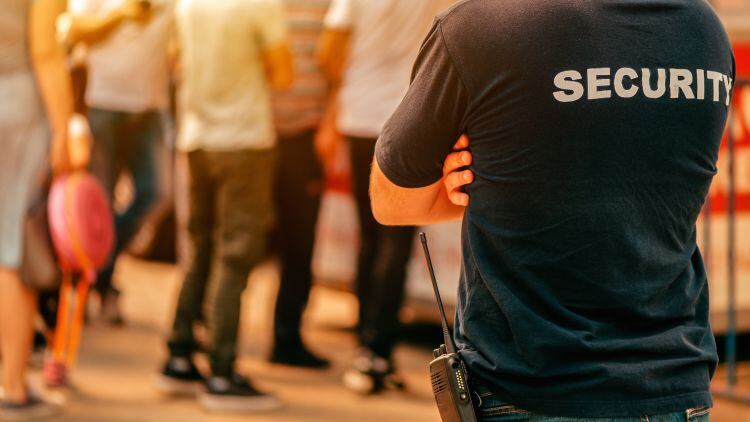All he can find is a set of jump leads. He puts them round his neck like a tie and walks hopefully back to the club. “Is this better?” he asks the doorman. “I’ll let you in” he says, “but don’t start anything”.
Alright, I’m not going to quit my day job and become a comedy writer just yet. My terrible joke aside, those of us working within the licensed trade understand the importance of our security personnel. In my licensing practice, I am starting to see more and more onerous security conditions being imposed on licences and the high-profile incidents of late 2022 are going to do nothing to assuage concerns of local residents and responsible authorities when considering licence applications or reviews. The trade is also likely to face greater challenges considering enhanced obligations which are likely to arise under Martyn’s Law (also known as the Protect Duty, a proposed piece of legislation designed to promoted security in the face of terrorist threats).
The problem is that security is not only important, it’s also expensive. I recently did some work with a national entertainment venue operator who have had to beef up their security complement to tackle incidents of anti-social behaviour which appears to have sprung up from out of nowhere - in some cases, having to double the number of hours where security staff are on the premises. And while costs continue to soar and profits decline, finding extra funds to pay for all this extra security poses a most unwelcome challenge.
With margins being what they are, it is easy to understand how some operators might be prepared to explore ways at saving a few quid on their bouncer bill. But if the recent spate of enforcement action by the Security Industry AUthority (SIA) is anything to go by, the risk is simply not worth it.
Rogue operators
In recent months, my regulatory news feed has been filled with stories of rogue security staff and operators being prosecuted for offences under the Private Security Act 2001. Those who work as unlicensed security run the risk of being prosecuted under section 3 which carries a fine of up to £5,000 and up to 6 months’ custody. Despite this, many still take the risk. In June 2022, a man appeared in Poole Magistrates’ Court for being an unlicensed director of a body corporate providing security services to various venues as well as working as unlicensed security staff himself. In December 2022, another man appeared in Wolverhampton Magistrates’ Court for unlicensed activities despite, according to one of the SIA’S Criminal Investigation Managers, being “unqualified and unsuitable to hold an SIA licence due to prior convictions”. And in January 2023 an individual appeared in Bradford Magistrates’ Court for working as security without a licence.
The SIA criminal investigations team has also recently clamped down on those who had used fake or falsified references to try and weasel their way to a licence. In February 2023, a man was sentenced to a community order after he pleaded guilty to forging documents to support his appeal against the refusal to grant him a licence.
Despite the regularity of such stories, the SIA actually appears to have uncovered less illegal activity recently. In 2021/2022 the SIA found 35 offences of undertaking licensable activity without a licence which contrasts with 72 in 2020/2021. Despite this apparent downward trend, those flouting the rules continue to make the headlines. This is hardly surprising considering the SIA have confirmed that they have undertaken 6,000 individual licence checks, more than a 200% increase on the previous year.
These difficulties arise at a time when there are noted difficulties in recruitment and retention of security guards. An SIA report published in November 2022 cites challenges such as low pay, unsociable hours and high levels of abuse as being some of the barriers to recruitment and retention.
Real risk
But surely the risk is all on the illegitimate guard. What about the company that employs them or the operator who hires the guard from the agency? There is a real risk for operators too as using unlicensed security operators and failing to check their credentials leaves them open to the possibility of prosecution, breach of licence conditions or even review. This is even the case where you hire security guards through an agency. Operators unfortunately cannot just assume that the security guards sent to them by agencies are above board and should protect themselves by undertaking basic checks on the operative’s credentials.
Although the SIA’s approach to enforcement is to prefer to work with operators to ensure compliance, one wonders what approach the SIA will take against such operators in light of these recent cases and the publication of advice on how operators can protect themselves. The SIA have stated “We have revised our Compliance, Enforcement & Supervision Strategy with our vision to be far more visible and proactive across the private security industry. We have increased our Inspection & Enforcement Resources (at no increase of the licence fee) from 50 plus operatives to over 100 operatives (Intelligence, Inspections and Criminal Investigation) who are all being upskilled to national investigative and intelligence standards”.
So what is the SIA advice? Each year 80,000 individuals take licence-linked qualifications to learn the skills necessary to work in security and with that, the SIA reminds employers to avail themselves of the easy to check security features of the SIA licence which include:
- on the front of the licence you should be able to see holograms when the licence is tilted backwards and forwards
- the expiry date of the licence is embossed on the bottom of the photograph (not printed on) – you should be able to run your finger over the date and feel that it is raised
- on the back of the licence there is a QR code and a bar code. The bar code should bring up the same licence number as shown on the licence
- a UV light should reveal ‘SIA’ in the top right and bottom left of the licence when scanned across the front. On older licences there will be a watermark pattern on the back of the licence that can only be revealed by the UV
- the address on the rear of the licence should show an ‘E’ post code
- Joe Harvey is an associate solicitor at Poppleston Allen




